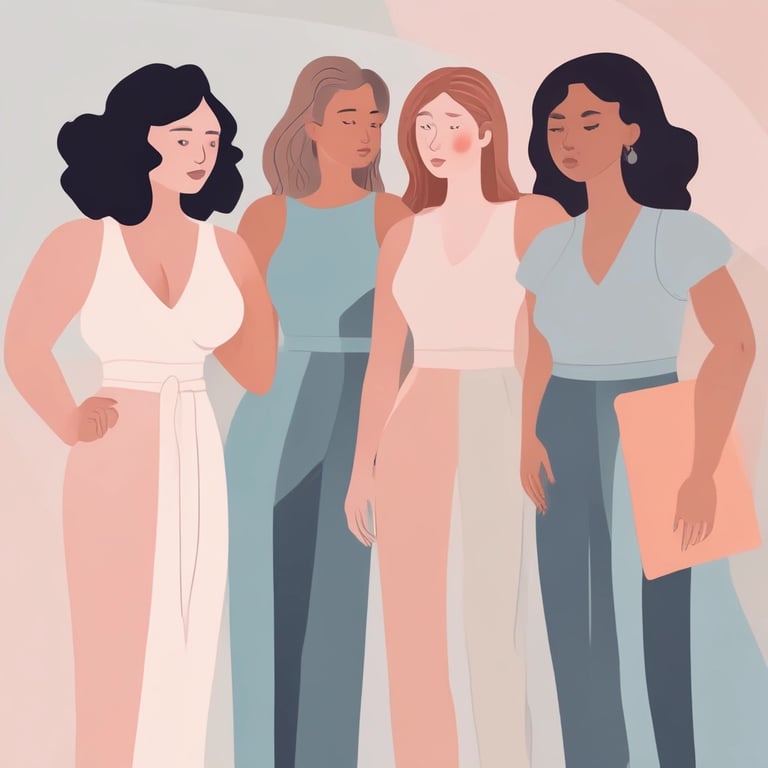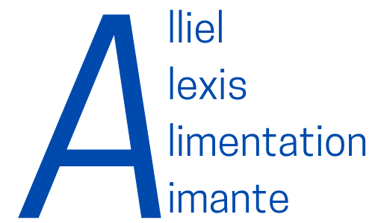The Female Body: Between Fashion, Standards, Ideals and Suffering
The Appearance Trap
In a society where image reigns supreme, the female body remains contested territory, torn between reality and representation. Every day, millions of women stand in front of their mirrors, confronted not only with their reflection but also with the echo of thousands of images that define what a "normal," "desirable," or "acceptable" body should be. But what is the reality of this oft-mentioned normality?
While storefronts, magazines, and screens ceaselessly celebrate a standardized and often unattainable female silhouette, anthropometric data tells a completely different story. A story of systematically erased morphological diversity, of invisible majorities, of a growing gap between real bodies and their idealized representations.
This disconnect is not trivial. It generates a constant stream of psychological suffering, behavioral restrictions, and negative self-judgments that silently poison the daily lives of many women. Weight thresholds transformed into moral verdicts, arbitrary measurements elevated to absolute truths, numbers that have become merciless judges of one's own value... How did we get here?
This article aims to explore, with figures and studies to support it, the extent of this gap between real and idealized bodies, to understand its psychological and social mechanisms, and to consider ways to finally reconcile women with the natural diversity of their morphologies.
The Real Female Body: Statistics versus Representations
The 2018 study by the French Institute of Textile and Clothing (IFTH) reveals a striking gap between real female morphologies and the standards of the fashion industry. This contrast is observed both in the distribution of sizes and in their media representation:
Real distribution vs. media visibility:
Sizes 32-34: approximately 3% of French women → nearly 40% of visuals in magazines and fashion shows
Sizes 36-38: about 10% of French women → around 50% of advertising silhouettes
Sizes 40-44: nearly 70% of French women → only 8-10% of media visibility
Sizes 46 and above: approximately 20% of French women → less than 2% of representation
These sizes 40-44, worn by the majority of French women, medically correspond to a Body Mass Index (BMI) of 20 to 24.9 – firmly within the range considered "normal" by World Health Organization standards. Yet, the fashion industry continues to glorify sizes 34-36, associated with a BMI often below 20.
Rigorous research (Swami et al., 2010; Crossley et al., 2012) highlights a considerable gap between perceptions and preferences:
Women generally aspire to achieve a very low BMI, between 18 and 19
Men, on the other hand, prefer female silhouettes with a significantly higher BMI, between 22 and 23
This disconnect, observed across different cultures, shows that the ideal of thinness that women impose on themselves is not only disconnected from the morphological reality of the majority of them but also from actual male preferences.
The IFTH's anthropometric measurements also revealed that the average waist circumference of French women has increased by 3.2 cm since 2006, the average hip circumference is 96.4 cm (far from the 90 cm presented as "standard"), and the gap between real measurements and industrial patterns has widened by 8% in ten years.
Adding to this complexity is the phenomenon of "vanity sizing": sizes are regularly adjusted to psychologically flatter consumers, with today's size 40 potentially corresponding to yesterday's 42-44. The update of data by the IFTH, planned for 2024, could finally push the industry to better reflect the true diversity of female bodies.
This persistent gap between reality and representation fuels intense social pressure, pushing the majority of women to consider their own bodies as "abnormal," even though they statistically embody the demographic norm.
Weight: Beyond the Number, an Identity Marker Loaded with Symbolism
The relationship with weight largely transcends the simple numerical data. It is deeply imbued with psychological and cultural thresholds that weigh heavily in our collective and individual imagination.
These Symbolic Thresholds That Shape Our Relationship with the Body
50 kg: A true symbol of thinness and control, this figure embodies an implicit ideal of feminine lightness in the collective imagination.
60 kg: A psychological boundary for many women, marking a perceived shift towards a weight deemed less conforming to dominant media standards.
70 kg and above: Often perceived as "outside the norm," this threshold crystallizes the fears and anxieties of those who have deeply internalized contemporary thinness dictates.
These figures, although arbitrary, exert considerable influence on behaviors, generating restrictions and prohibitions that many women impose on themselves:
"I won't buy a swimsuit until I've lost 5 kilos"
"I won't wear a tight dress until I reach 60 kg"
"I won't post photos in summer outfits on social media until I've lost my cellulite"
"I won't go to that pool party until I have a flatter stomach"
"I won't start dance classes until I've reached my ideal weight"
"I won't go to that job interview until I've lost weight"
These statements, heard daily, reveal how weight becomes a prerequisite for social participation, leisure activities, and even professional advancement. According to a study published in Body Image (2018), nearly 60% of women regularly postpone important social activities due to weight-related dissatisfaction, while approximately 15-20% of men act similarly.
This pressure is not limited to diet: it profoundly influences the relationship with clothing, social relations, and even professional confidence. A woman who crosses a symbolic threshold may feel illegitimate in certain social spaces or avoid outfits deemed "unsuitable" for her morphology. Even more seriously, some women postpone medical examinations or essential health check-ups for fear of judgment about their weight, as revealed by several studies published in medical journals, indicating that about one-third of overweight women have already delayed medical consultations for this reason.
Units of Measurement: When Culture Biases Our Perception
The way weight is measured varies considerably across countries and cultures, subtly influencing our perception:
1 kilogram equals 2.2 pounds (lbs) in the United States and the United Kingdom
1 stone represents 6.35 kg in the United Kingdom
Thus, 60 kilograms transform into 132 pounds or 9.4 stones depending on the unit used. This semantic variation is not trivial: depending on the unit employed, the same weight can seem psychologically more or less "acceptable."
The arbitrary nature of these metric referents deserves to be emphasized. The kilogram, originally defined as the weight of a liter of water, or the pound historically based on the weight of a certain number of wheat grains, have no intrinsic link with the human body or health. Yet, these abstract units are invested with considerable emotional power. Saying "I weigh 70 kg" or "I weigh 154 lbs" can generate completely different emotional reactions, although it is exactly the same body mass.
The cultural relativity of these units is striking:
In France, crossing the symbolic threshold of 60 kg can be experienced as traumatic
In the United States, anxiety crystallizes more around the threshold of 150 pounds (68 kg)
In the United Kingdom, it is often the passage to a new "stone" (6.35 kg) that causes excessive anxiety
This cultural dimension underscores how our relationship with weight is a social construction rather than an objective biological reality. The numbers themselves, having become identity markers charged with emotion, illustrate how culture profoundly shapes our view of the body and our very conception of what is "normal" or "acceptable."
Media and Industry: Shared Responsibility and Potential for Change
The textile industry and the media bear major responsibility in constructing and maintaining these often unattainable standards. By celebrating frequently retouched bodies, they establish an artificial ideal and exploit the generated dissatisfaction to market clothing, weight loss diets, or "miracle" products.
While some brands are beginning to incorporate more diversity into their campaigns and collections, these efforts remain marginal against a system that continues to value thinness as a privileged commercial argument.
A profound ethical reflection is necessary to reduce the destructive impact of these standardized images on women's mental and physical health. Raising awareness about body diversity and media education constitute crucial paths to progressively deconstruct these deeply rooted oppressive norms.
Towards a Reconciliation Between Real Bodies and Representations
The perception of the female body remains imprisoned today in a constraining vice: rigid clothing standards, unrealistic media ideals, and arbitrary numerical references. Between an intrinsically diverse bodily reality and norms that evolve too slowly, women continue to endure paradoxical injunctions that undermine their daily well-being.
To move forward collectively, it becomes imperative to fundamentally rethink these limiting representations, to align the textile industry with contemporary morphologies, and to promote a critical reading of the images that surround us. The anthropometric data update expected in 2024 could mark a significant turning point, provided that all concerned actors – industrialists, media, and consumers – resolutely engage in this approach.
Reclaiming one's body, by gradually freeing oneself from external dictates, constitutes today a profoundly liberating and essential act for contemporary women. This individual approach, when it becomes collective, carries within it the potential for a profound transformation of our relationship with the body and the diversity that intrinsically characterizes it.
📚 Further Reading: Explore our analysis of fatphobia as systemic discrimination and learn how to cope in a fatphobic world. Discover our non-diet obesity management approach.
Sources and References:
French Institute of Textile and Clothing (IFTH), 2018 – "National Campaign for Measurement and Morphological Analysis of the French Population"
World Health Organization (WHO), "BMI Classification", 2020
Swami, V., Frederick, D. A., Aavik, T., et al. (2010). "The Attractive Female Body Weight and Female Body Dissatisfaction in 26 Countries Across 10 World Regions: Results of the International Body Project I." Personality and Social Psychology Bulletin, 36(3), 309-325.
Crossley, K. L., Cornelissen, P. L., & Tovée, M. J. (2012). "What Is an Attractive Body? Using an Interactive 3D Program to Create the Ideal Body for You and Your Partner." PLOS ONE, 7(11), e50601.
Becker, C.B., Verzijl, C.L., et al. (2018). "Body image avoidance: An under-explored yet important factor in the relationship between body image dissatisfaction and disordered eating." Body Image, 25, 182-190.
Drury, C.A., Louis, M. (2002). "Exploring the association between body weight, stigma of obesity, and healthcare avoidance." Journal of the American Academy of Nurse Practitioners, 14(12), 554-561.
Grabe, S., et al., "The Role of the Media in Body Image", Psychological Bulletin, 2008
American Psychological Association, "Meta-Analysis on Media and Eating Disorders", 2017
Puhl, R. M., & Heuer, C. A., "The Stigma of Obesity", Obesity Reviews, 2009
Fredrickson, B. L., & Roberts, T. A., "Objectification Theory", Psychology of Women Quarterly, 1997
Bordo, S., "Unbearable Weight: Feminism, Western Culture, and the Body", University of California Press, 2003
Wolf, N., "The Beauty Myth", HarperCollins, 1991
Levine, M. P., & Murnen, S. K., "Media and Body Image", American Psychologist, 2009


Vivre et manger sont les deux faces de la même pièce
Lighten your relationship with food and free yourself from what hinders you!
+33 6 22 41 55 21
© 2024. All rights reserved.
RPPS : 10007258733
N° ADELI : 75 95 0878 1
